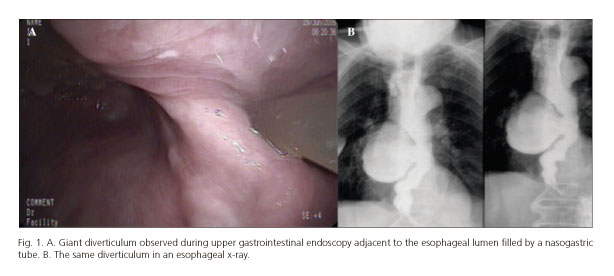Mi SciELO
Servicios Personalizados
Revista
Articulo
Indicadores
-
 Citado por SciELO
Citado por SciELO -
 Accesos
Accesos
Links relacionados
-
 Citado por Google
Citado por Google -
 Similares en
SciELO
Similares en
SciELO -
 Similares en Google
Similares en Google
Compartir
Revista Española de Enfermedades Digestivas
versión impresa ISSN 1130-0108
Rev. esp. enferm. dig. vol.109 no.4 Madrid abr. 2017
https://dx.doi.org/10.17235/reed.2017.4528/2016
CARTAS AL EDITOR
Giant esophageal diverticulum as a new clinical indication for endoscopic gastrostomy
Key words: Esophageal diverticulum. Endoscopic gastrostomy. PEG.
Dear Editor,
Persistent mechanical or functional dysphagia is the most common clinical indication for endoscopic gastrostomy (PEG). However, current guidelines do not address additional less common conditions that may justify prolonged enteral feeding beyond the usual oncologic and neurologic disorders.
Case report
A 76-year-old man was referred to our artificial feeding outpatient clinic due to persistent dysphagia, weight loss and several episodes of aspiration and pneumonia. Significant malnutrition was evident (body mass index: 15 kg/m2). An upper gastrointestinal endoscopy was performed, showing a tortuous esophagus and a giant diverticulum with a wide neck and food debris (Fig. 1A). Ineffective peristalsis and transient lumen esophageal stenosis were observed. A nasogastric tube was passed under endoscopic guidance in order to start enteral feeding immediately. Esophageal x-ray and a computed tomography (CT) scan confirmed a 9 cm long esophageal diverticulum (Fig. 1B). Given the advanced age, the impossibility for endoscopic therapy and the potential complications from surgical resection, the patient underwent PEG a few days later. After the procedure, nutritional status improved and no additional aspiration occurred.
Discussion
Esophageal diverticula are unusual congenital or acquired malformations of the gastrointestinal tract and include pharyngoesophageal (Zenker's), mid-esophageal (traction) and epiphrenic diverticula (1-4). Large symptomatic diverticula are traditionally managed by surgery via esophageal myotomy and diverticulectomy (or diverticulopexy); however, an endoscopic approach may be considered in selected cases (1,3). Nevertheless, we believe that PEG could be an effective option for long-term enteral feeding in elderly patients with high surgical risk, avoiding aspiration caused by dysphagia and preventing malnutrition. Dysphagia, regurgitation and aspiration pneumonia due to giant esophageal diverticula emerge as new clinical indications for PEG not previously reported in literature.
Gonçalo Nunes1, Carla Adriana Santos1 and Jorge Fonseca1-2
1Gastroenterology Department. GENE - Artificial Feeding Team.
Hospital Garcia de Orta. Almada, Portugal.
2CiiEM - Centro de Investigação Interdisciplinar Egas Moniz.
Monte da Caparica, Portugal
References
1. Cassivi SD, Deschamps C, Nichols FC, et al. Diverticula of the esophagus. Surg Clin North Am 2005;85(3):495-503. DOI: 10.1016/j.suc.2005.01.016. [ Links ]
2. Costantini M, Zaninotto G, Rizzetto C, et al. Oesophageal diverticula. Best Pract Res Clin Gastroenterol 2004;18(1):3-17. DOI: 10.1016/S1521-6918(03)00105-7. [ Links ]
3. Herbella FA, Patti MG. Modern pathophysiology and treatment of esophageal diverticula. Langenbecks Arch Surg 2012;397(1):29-35. DOI: 10.1007/s00423-011-0843-2. [ Links ]
4. Smith CD. Esophageal strictures and diverticula. Surg Clin North Am 2015;95(3):669-81. DOI: 10.1016/j.suc.2015.02.017. [ Links ]














